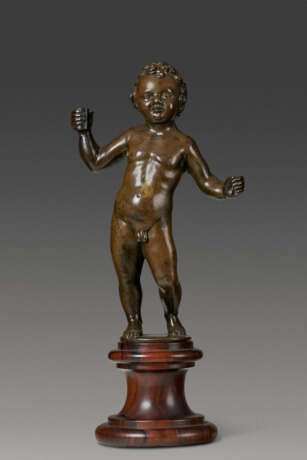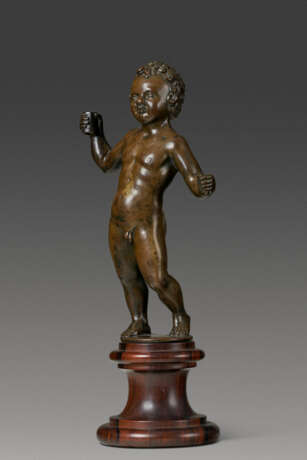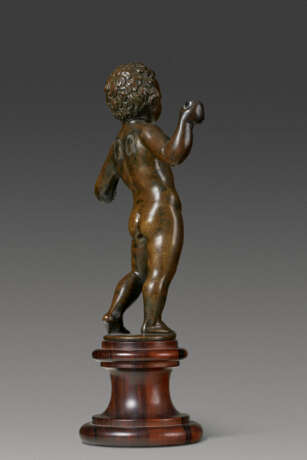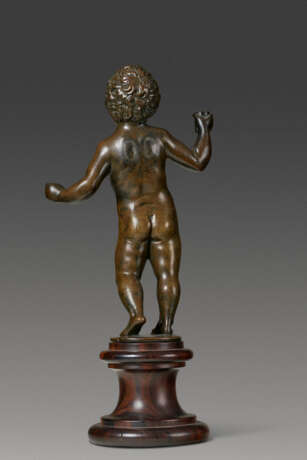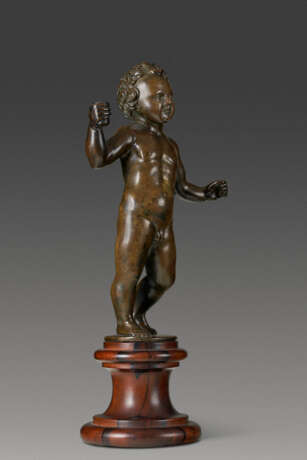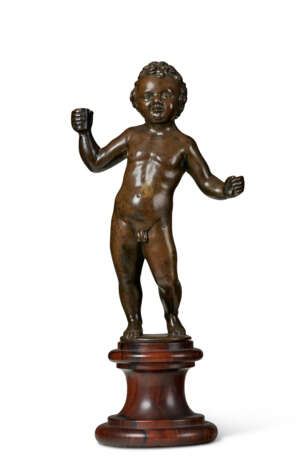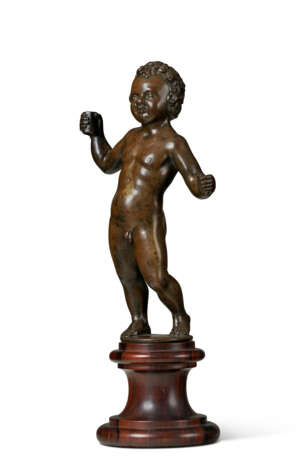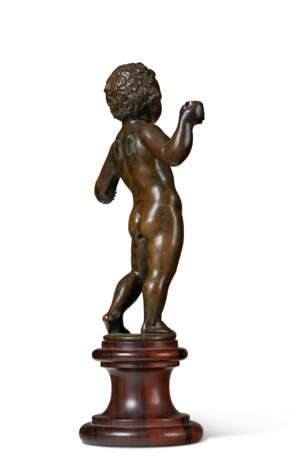ID 1230059
Lot 12 | PROBABLEMENT ANVERS, VERS 1535-1540
Estimate value
€ 15 000 – 25 000
Putto
bronze, reposant sur un socle postérieur en bois tourné
H. 20,3 cm (8 in.) ; H. totale 27,5 cm (10 ½ in.)
Provenance
Dr. Walter von Pannwitz (mort en 1920), Haarlem.
Avec Julius Böhler, Munich, 1971.
Collection Claudia Quentin.
Literature
S. Meller, Die Deutschen Bronzestatuetten der Renaissance, Florence, 1926, pl. 34.
BIBLIOGRAPHIE COMPARATIVE
E. F. Bange, Die deutschen Bronzestatuetten des 16 Jahrhunderts, Berlin, 1949, p. 72-73 (illustré) et p. 134, n°130(a).
K. Pechstein, Bronzen und Plaketten, Berlin, 1968, n°45 (inv. K4298).
Exhibited
New York, The Frick Collection, European Bronzes from the Quentin Collection, 28 septembre 2004 - 2 janvier 2005, pp. 214-217, no. 21.
Further Details
A BRONZE FIGURE OF A PUTTO, PROBABLY ANTWERP, CIRCA 1535-1540
The refined execution of this bronze contrasts with its likely utilitarian purpose; it is thought to be a candlestick, as indicated by the hollow threaded cylinder in the putto's proper right hand. The figure’s balanced contrapposto, characteristic of Italian Mannerism, is unusual in the context of German bronzes of this period.
In 1949, E. F. Bange compared the bronze from the Quentin collection with putti on the tomb of Fürstbischofs Jacob von Croy in the Domschatzkammer, Cologne, which are given to an anonymous sculptor from Leuven/Louvain and dated to around 1518-1520, on the basis of their similar long waists and broad hips. This argument was supported by K. Pechstein in 1968, who compared the putti on the Croy monument with a dinanderie figure of a Putto standing beside a Candlestick in the Kunstgewerbemuseum, Berlin (inv. no. K4298 h. 32.5 cm), which is dated 1566.
The marks between his shoulders on his back indicate that the Putto originally had wings, which are now missing. The modelling and after working of the curly hair, with the well-defined spiral crown at the back of the head, are quite remarkable. Indeed, the craftsmanship is unusually refined for a functional bronze, indicating perhaps that this maker’s works were usually intended for more elevated purposes.
Please note a scanned copy of the full catalogue entry from the catalogue of the 2004 Quentin Collection exhibition at The Frick Collection, New York, is available upon request.
| Applied technique: | Metalwork |
|---|---|
| Medium: | Bronze |
| Place of origin: | Belgium, Western Europe, Europe |
| Auction house category: | Sculptures, Statues & Figures |
| Applied technique: | Metalwork |
|---|---|
| Medium: | Bronze |
| Place of origin: | Belgium, Western Europe, Europe |
| Auction house category: | Sculptures, Statues & Figures |
| Address of auction |
CHRISTIE'S 9 Avenue Matignon 75008 Paris France | ||||||||||||||
|---|---|---|---|---|---|---|---|---|---|---|---|---|---|---|---|
| Preview |
| ||||||||||||||
| Phone | +33 (0)1 40 76 85 85 | ||||||||||||||
| Fax | +33 (0)1 40 76 85 86 | ||||||||||||||
| Conditions of purchase | Conditions of purchase | ||||||||||||||
| Shipping |
Postal service Courier service pickup by yourself | ||||||||||||||
| Payment methods |
Wire Transfer | ||||||||||||||
| Business hours | Business hours
|
